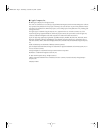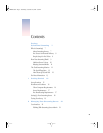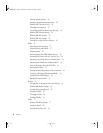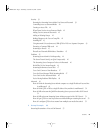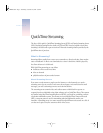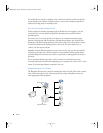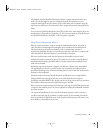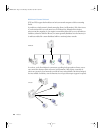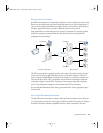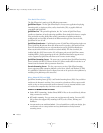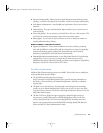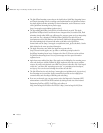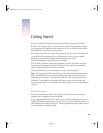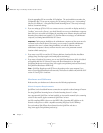QuickTime Streaming
9
A PowerBook G4 with QuickTime Broadcaster software captures and encodes video and
audio. The encoded signal is sent over an Internet Protocol (IP) network to a server
computer running QTSS or DSS software. QTSS or DSS on the server computer sends the
signal over the Internet or a local network to client computers that tune in using QuickTime
Player.
You can also run QuickTime Broadcaster and QTSS or DSS on the same computer. If you are
broadcasting to a large audience (more than, say, 100), however, Apple recommends that you
run QuickTime Broadcaster and QTSS or DSS on separate computers.
How Does Streaming Work?
When you watch and listen to cable or over-the-air media transmissions on television or
radio, the cable or electromagnetic wavelengths used are dedicated to that transmission.
Those transmissions are mostly uncompressed and so consume large amounts of
transmission bandwidth. But that’s not a problem, because they don’t have to compete with
other transmissions within the frequency over which they’re broadcast.
When you send that same media over the Internet, the bandwidth used is no longer
dedicated to only that transmission stream. The media now has to share extremely limited
bandwidth with thousands, potentially millions, of other transmissions traveling back and
forth over the Internet.
Multimedia sent over the Internet is therefore encoded and compressed for transmission.
The resulting files are saved in a specific location, and streaming server software such as
QuickTime Streaming Server or Darwin Streaming Server is used to send the media over the
Internet to client computers.
Streamed media can be viewed by both Macintosh and Windows users using QuickTime
Player (available free on the Apple web site) or any other application that supports
QuickTime or standard MPEG-4 files. Streams can also be set up so that users can view them
from within a web browser when the QuickTime plug-in is installed.
When a user starts to play streamed media through a web page, the QuickTime plug-in sends
a request to the streaming server. The server responds by sending the multimedia content to
the client computer.
The type of multimedia that is sent to the client computer depends on what content you
specified on the web page. If you linked to a playlist created on the streaming server, that’s
sent. If you linked to a QuickTime movie in the specified media directory, that movie is sent.
If you linked to a live broadcast, that’s sent.
LL0329.book Page 9 Wednesday, November 20, 2002 2:09 PM




